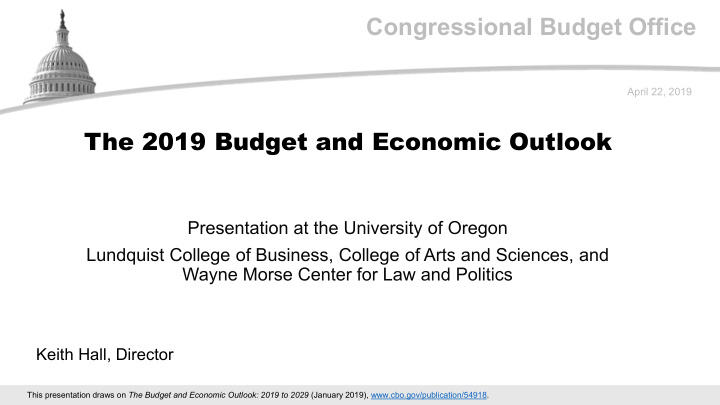



Congressional Budget Office April 22, 2019 The 2019 Budget and Economic Outlook Presentation at the University of Oregon Lundquist College of Business, College of Arts and Sciences, and Wayne Morse Center for Law and Politics Keith Hall, Director This presentation draws on The Budget and Economic Outlook: 2019 to 2029 (January 2019), www.cbo.gov/publication/54918.
CBO Deficits Values are adjusted to exclude the effects of shifts in the timing of payments that occur when October 1 (the first day of the fiscal year) falls on a weekend. Shaded vertical bars indicate periods of recession. 1
CBO Debt Held by the Public 2
CBO Economic Projections 3
CBO Growth of Real GDP Percent 2019 2020 Middle Two-Thirds of the Range of Estimates From the January 2019 Blue Chip 2.4 – 2.8 1.5 – 2.3 Survey of Private-Sector Forecasters CBO 2.7 1.9 Growth is measured from the average of one calendar year to the next. GDP = gross domestic product. 4
CBO Real GDP and Potential Real GDP Shaded vertical bars indicate periods of recession. GDP = gross domestic product. 5
CBO Factors Underlying the Growth of Potential GDP GDP = gross domestic product. 6
CBO The Unemployment Rate and the Natural Rate of Unemployment Shaded vertical bars indicate periods of recession. 7
CBO Inflation Shaded vertical bars indicate periods of recession. PCE = personal consumption expenditures. 8
CBO Interest Rates Shaded vertical bars indicate periods of recession. 9
CBO Budget Projections 10
CBO Deficits Values are adjusted to exclude the effects of shifts in the timing of payments that occur when October 1 (the first day of the fiscal year) falls on a weekend. 11
CBO Revenues and Outlays Values are adjusted to exclude the effects of shifts in the timing of payments that occur when October 1 (the first day of the fiscal year) falls on a weekend. 12
CBO Federal Outlays, by Category Values are adjusted to exclude the effects of shifts in the timing of payments that occur when October 1 (the first day of the fiscal year) falls on a weekend. 13
CBO Major Changes in Projected Outlays From 2019 to 2029 Values are adjusted to exclude the effects of shifts in the timing of payments that occur when October 1 (the first day of the fiscal year) falls on a weekend. 14
CBO Outlays for People Age 65 or Older as a Share of Total Noninterest Outlays Values are adjusted to exclude the effects of shifts in the timing of payments that occur when October 1 (the first day of the fiscal year) falls on a weekend. 15
CBO Total Revenues 16
CBO Revenues, by Major Source Other revenue sources consist of excise taxes, remittances from the Federal Reserve System, customs duties, estate and gift taxes, and miscellaneous fees and fines. 17
CBO Debt Held by the Public 18
CBO If productivity growth turned out to be half a percentage point higher from 2020 to 2029 than CBO projects, deficits would average 3.7 percent of GDP instead of 4.4 percent. If interest rates on 10-year Treasury notes were 3.0 percent (rather than averaging 3.7 percent as in CBO’s 10-year forecast), deficits would average 4.0 percent of GDP (instead of 4.4 percent). 19
CBO On net, in CBO’s baseline, the 2017 tax act increases the deficit by $1.9 trillion from 2018 to 2028, including debt-service costs. That estimate includes the effects of economic changes resulting from the act, which offset 30 percent of the impact on the primary deficit and 20 percent of the total impact on the deficit including debt-service costs. 20
CBO Growth in Individual Income Tax Receipts in CBO’s Baseline Projections Real bracket creep is the process in which, as income rises faster than inflation, an ever-larger proportion of income becomes subject to higher tax rates. 21
CBO Projected Deficits, 2020 to 2029 22
CBO Projected Deficits Under CBO’s Baseline and an Alternative Fiscal Scenario Values are adjusted to exclude the effects of shifts in the timing of payments that occur when October 1 (the first day of the fiscal year) falls on a weekend. 23
Recommend
More recommend